It is July. It is hot. And I am with my friend Ian, near Concord, Massachusetts, on a day organized around the kind of literary activities we both enjoy. Our plan is to spend the morning in the archive at the Thoreau Institute and, after sifting through a few old books and images, to take a walk in the woods. Not just any walk, but a deliberate circumambulation around the hallowed waters of Walden Pond.
Both our visit to the Institute and our Thoreauvian circum-saunter is research for Ian’s next book. It is also a fine excuse to be together on a sticky mid-summer New England day. But soon after we are on the trail, and our conversation about poetry and conviviality runs its course, we feel the heat and meander off the trail to the pond’s edge. There we shed our shoes and wriggle our toes into the moist sand as we wade out into the shallows.
Walden pond is a lovely place for a swim––and we are not the only people floating about in the cool water. There are swimmers in goggles, and there are people in kayaks and canoes, as well as various kinds of floaties. The scene is downright convivial. But then, after a dive under the cool water, I surface and see down the shoreline two towers of stacked stones.
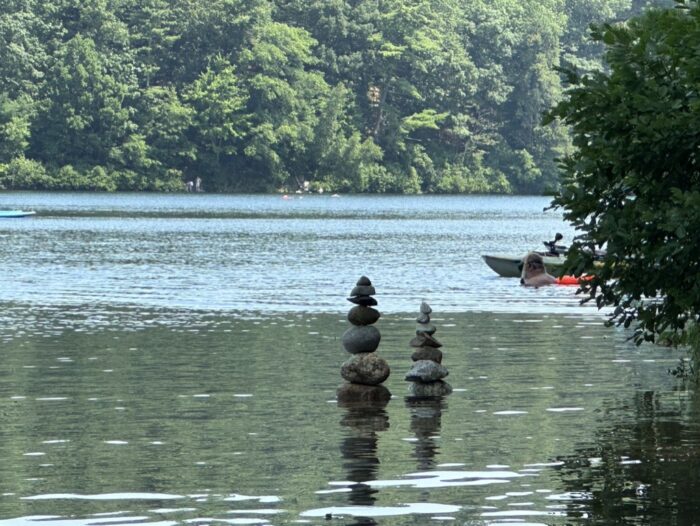
It seems there is a great deal of interest in stacking stones––wherever one might find them. Though the practice is not without controversy. Consider the title of a recent essay in The Guardian: “Stone stacking: cool for Instagram, cruel for the environment.” But whether cool or cruel, the impacts of this freelance stonework are, as one writer not-too-cleverly puts it, “stacking up.”
The debate about today’s stone stackers is part of the cultural history of cairn building. Though “the differences between the two are immense,” according to one learned commentator:
“A cairn is an officially established pile of rocks designed to mark a trail. These are made by land managers to properly blaze the designated trail so hikers will follow the most durable surfaces. In many cases, cairns are used above tree line and in alpine type environments where painted blazes are not as visible in the relatively open landscape. Tampering with them can lead other visitors to become lost and/or trample sensitive vegetation. . . . “
The “officially” sanctioned and “properly” placed cairns, this writer intones, “must be left as they are, following the fourth principle of Leave No Trace, Leave What You Find.” The idea here, to follow this writer’s reasoning, is that cairns built by “land managers” to control human impact in sensitive areas are different from rock pile enthusiasts who build cairns for fun and creative expression or as part of a more reverential or spiritual ritual.
But as more and more people find reasons to stack stones, according to Robyn Martin in High Country News, the more we are faced with an annoying plague of rearranged pieces of rock balanced carefully atop one another in the West:
“These piles aren’t true cairns, the official term for deliberately stacked rocks. From middle Gaelic, the word means ‘mound of stones built as a memorial or landmark.’ There are plenty of those in Celtic territories, that’s for sure, as well as in other cultures; indigenous peoples in the United States often used cairns to cover and bury their dead. Those of us who like to hike through wilderness areas are glad to see the occasional cairn, as long as it’s indicating the right way to go at critical junctions in the backcountry.”
There is that word “official” again. Not to mention the definitive “true cairns.” As it happens, the comments on this article include people on all sides of the debate. One is from an earnest and “avid stone balancer” named Peter Juhl:
“I teach classes on the art form and give presentations on it regularly. I published the first widely available guidebook on rock and stone balancing. I love this art form and want to see it grow. However, I am very concerned about the practice of leaving stacks of stones littering natural areas. There is a large worldwide community of stone balance artists who share this concern, and who practice a leave-no-trace approach in creating our temporary art. We build our balances, take some photos, and then dismantle. We strive especially to avoid disturbing natural and protected areas.”
While I can’t think of anything worth doing or any place worth going that has been improved by a guidebook––or for that matter “the practice of leaving stacks of stones littering natural areas”––I must admit that a part of me admires Juhl’s enthusiasm for stacking stones. Decades ago, guiding a sea kayaking expedition in Glacier Bay, Alaska, I came across a rocky shoreline festooned with stacked stone towers that fell into the waters with the rising tide. Looking back, it seems to me that a tidal shoreline may in fact be a perfect place for stacked stone towers: for as the tide rose the sound of falling stones marked an elegant reclamation of the displaced stones, almost even a “leave-no-trace approach” and the creation of “temporary art”––that is, if one does not factor in the critters living in the tidal stone beds along the shore.
So maybe we do need Martin’s less equivocal point of view. “Pointless cairns are simply pointless reminders of the human ego.”
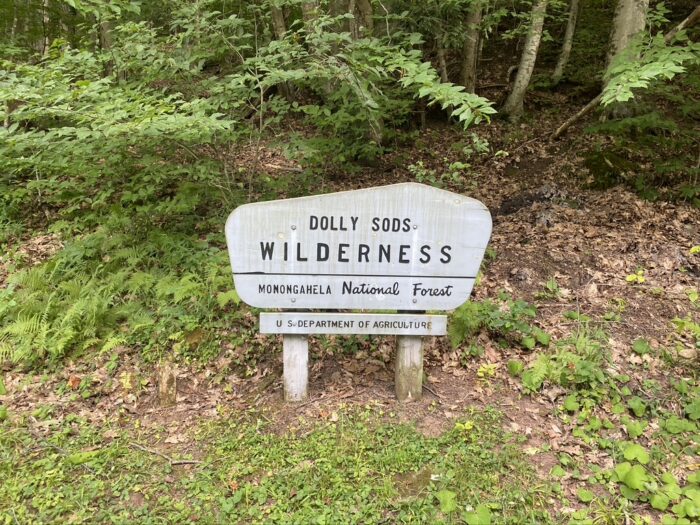
This line of thinking about stacking stones began in conversation with a group of friends a couple of years ago––on a trail in the Dolly Sods wilderness in West Virginia. The conversation included a spontaneous debate about cairns. My own view of cairns had been shaped by decades of hiking and climbing in the West. I had considered the uses (and abuses) of those little (or larger) rock piles that guide hikers and climbers and keep them on the trail, especially in rough terrain. And for decades I instinctively kicked over cairns because I was not convinced that they were necessary to keep people off vulnerable areas near the trail. But then this was decades ago, at a time when hiking was less popular and hence there was less pressure on vulnerable plants in these high mountain areas.
In West Virginia, the conversation warmed a bit when I announced my aversion to the cairn––both the idea and the thing. In fact, on less-traveled routes in the high mountains of the far west, I explained to my friends, I routinely ( if not righteously) knocked down small cairns that I had determined were unnecessary. But back east, in the Dolly Sods, we were on a well-travelled trail. And wouldn’t you know it, we lost our way a couple of times and were forced to backtrack through bushes and brambles to reconnect with the trail. When descending, later in the day, we spotted a stone cairn in a dry riverbed. And before I knew it the most irreverent in our group picked up a stone, looked over at me, and tossed it at the cairn.
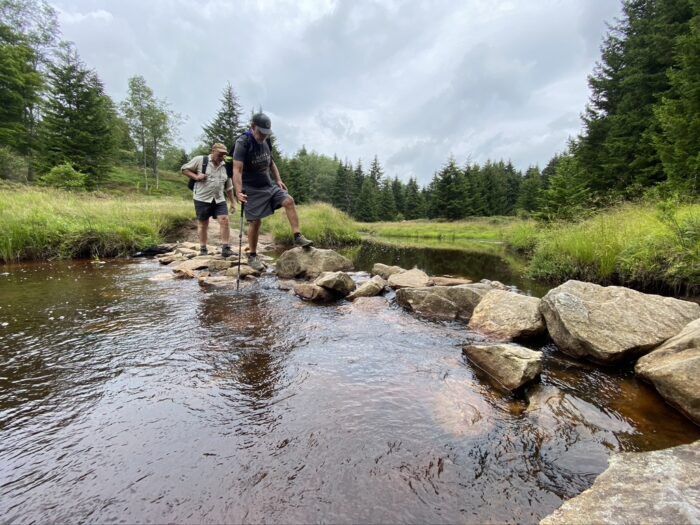
We might call the practical study of such matters “cairnology.” It might be the case, in fact, that “comparative ciarnology” would document their uses in distinct cultures and landscapes. I began my own studies in the field with John Cair’s entry on the cairn in the 1911 Encyclopædia Britannica, a fine overview of the ancient history of cairns, perhaps as good a place as any to begin. The entry begins with the etymology of the world and then recounts the history (“CAIRN (in Gaelic and Welsh, Carn) of heaps of stones piled up in a conical form.”
In modern times, Cair explains, cairns were often erected as landmarks. In ancient times, however, “they were erected as sepulchral monuments.” And a dedicated cairnologist might find this piece of information in his entry of interest:
“The Duan Eireanach, an ancient Irish poem, describes the erection of a family cairn; and the Senchus Mor, a collection of ancient Irish laws, prescribes a fine of three three-year-old heifers for “not erecting the tomb of thy chief.” Meetings of the tribes were held at them, and the inauguration of a new chief took place on the cairn of one of his predecessors. It is mentioned in the Annals of the Four Masters that, in 1225, the O’Connor was inaugurated on the cairn of Fraech, the son of Fiodhach of the red hair.”
“In medieval times cairns are often referred to as boundary marks, though probably not originally raised for that purpose. In a charter by King Alexander II. (1221), granting the lands of Burgyn to the monks of Kinloss, the boundary is described as passing ‘from the great oak in Malevin as far as the Rune Pictorum,’ which is explained as ‘the Carne of the Pecht’s fieldis.’ In Highland districts small cairns used to be erected, even in recent times, at places where the coffin of a distinguished person was ‘rested’ on its way to the churchyard. Memorial cairns are still occasionally erected, as, for instance, the cairn raised in memory of the prince consort at Balmoral, and “Maule’s Cairn,” in Glenesk, erected by the earl of Dalhousie in 1866, in memory of himself and certain friends specified by name in the inscription placed upon it. “
In the annals of cairnology, again and again, one finds that the stacking or heaping of stones is intimately related to cultural practices––whether these practical uses such as marking boundaries or communal acts of memory and commemoration. Like carving our initials into the soft white bark of a birch or chopping a blaze into a small pine or spruce tree long the trail, the cairn has proved to be a widely-used marker of human presence and passage.
Back at Walden Pond we left the stacked stones standing in the water. Though there are no tides in this famous New England pond. We also knew as readers of Thoreau that we had other lives to live. So we laced up our shoes and continued on our way. We passed alongside the railway bed to the cabin site. Where once again we found ourselves face-to-face with a cairn. For among those who had made a pilgrimage to the cabin site were people had built their own stone towers on top of the cairn. There were literally dozens of them. The stone balance artists had come and gone. The stones remained. . . . “Stacks of stones littering natural areas.”
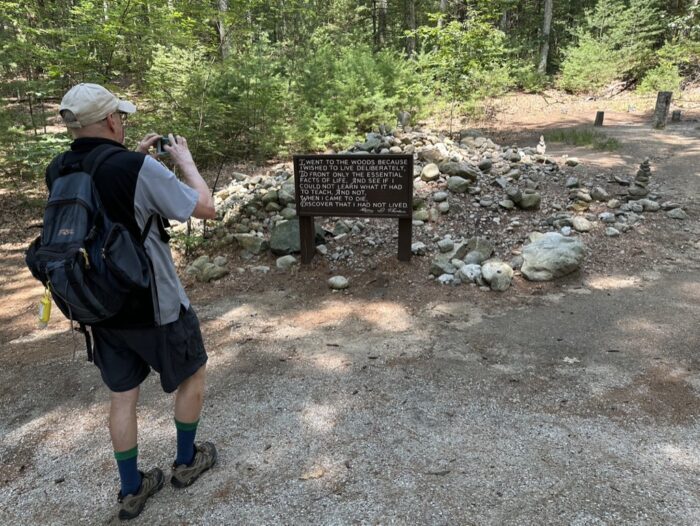
Back home at my desk I considered that the stacks of stones were not littering a “natural” area. Thoreau’s cabin site is not natural. The stacked stones were all resting on a less artful pile of stones. As it turns out, in September 1863, Bronson Alcott and his daughter Abigail May noted on a walk to Walden Pond that “the grounds are much overgrown with shrubbery, and the site of the hermitage is almost obliterated.” On a later date William Ellery Channing noted the same. Then, in June 1872, Mrs. Mary Newbury Adams, of Dubuque, Iowa, inaugurated the memorial cairn to commemorate the site. Here is the account by the geologist Robert Thorson:
She had been in town visiting the Emersons when Bronson Alcott stopped by on his way to the Unitarian Church picnic at Walden Pond. Mrs. Adams joined him for the walk and relayed the experience to her daughter, who later described it in the following way:
“When they reached the spot where Thoreau’s little house used to stand, mother said it was a pity there was nothing to mark the place, so strangers might know it. ‘Well, said Mr. Alcott, ‘a cut stone would hardly be appropriate, would it, for Thoreau?’ She suggested building a cairn and then let everyone who loved Thoreau add a stone and said she was going to start it right then. She got a stone and with a little improvised ceremony laid it down in her own name. Then Mr. Alcott got one for himself and one for Mrs. Alcott. “
The other pity, I might suggest, was the comment from the woman named Mary from Iowa.
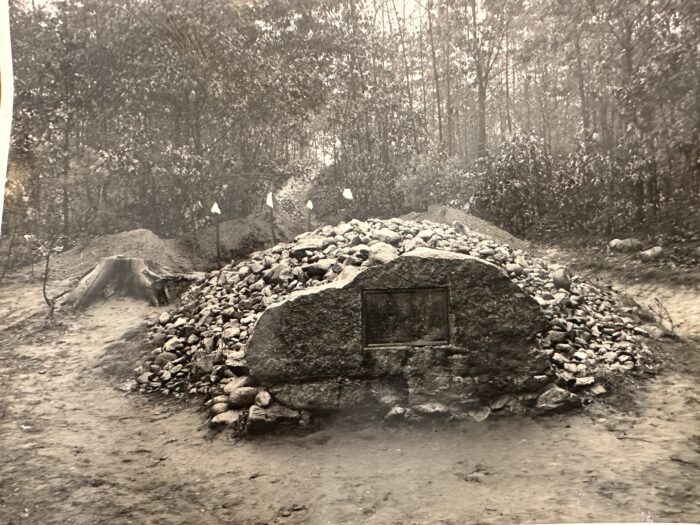
In the Thorson account, “Mrs. Adams and Mr. Alcott began their cairn near the former front door of the house. Over the years, it became a growing cone of loose stone. A bronze plaque was later affixed to a nearby boulder to communicate what was being marked. By the late 1870s, pilgrims were coming from afar, often escorted by Ralph Waldo Emerson, Bronson Alcott, Ellery Channing, Frank Sanborn, or Fred Homer.
As a reader and scholar of Emerson, I am still coming to terms with him as a Cairn enabler.
But the cairn grew, as cairns will do. And then, in 1975, Thorson explains,
“without consulting the Thoreau Society, the park director had the previous cairn trucked away because he thought it looked ugly. When the Thoreau Society learned that their sacred memorial had gone missing, their howls of protest forced the director to rethink his decision. With reluctance, the state of Massachusetts trucked the stones back to create the modern mound.”
The further this story unfolds the more absurd it becomes. A god-damned truck took the cairn away and then the truck brought it back! And all of this at Walden Pond.
The account of this affair led my ambivalence about cairns to bubble up like a canker sore on my lip—that is, until I read what E. B. White included in his posthumous personal letter to Henry:
“Your front yard is marked by a bronze tablet set in a stone. Four small granite posts, a few feet away, show where the house was… Back of it is a pile of stones, a sort of cairn, left by your visitors as a tribute I suppose. It is a rather ugly little heap of stones.”
Perfect. “A sort of cairn,” raising once again the existential question, although the venerable White brings it back to the quotidian with a fine little phrase, “a rather ugly little heap of stones.”
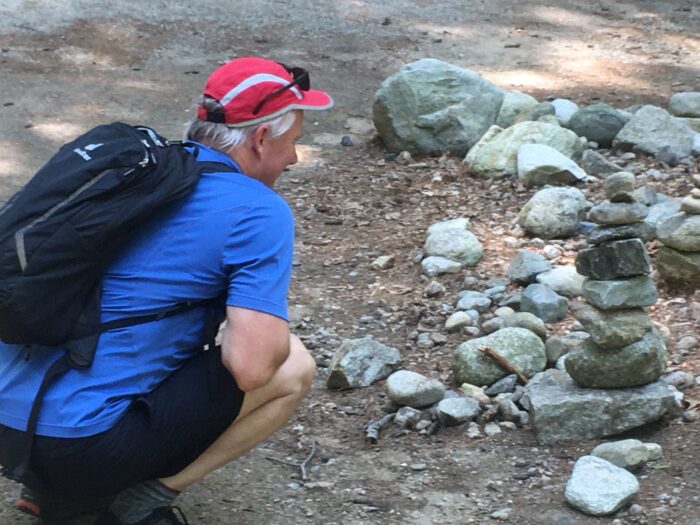
Having considered some of the foundational questions in the discipline of cairnology I believe I am more informed about both the uses and the abuses of heaping stones. On well-travelled routes, the cairn has its uses, I will admit, as cairns can keep the less attentive among us (or less experienced) off delciate terrain, most especially the sites with vulnerable plants or other areas susceptible to the stiff rubber edge of a vibram sole.
But I can be stubborn. And my position has not changed. If I had to choose a term to describe my position on cairns it would be ambivalent. Though to be perfectly honest I really do loathe cairns. For me, the cairn is first and foremost an affront to the way things are (or were). Because the cairn is intended to mark the presence and/or passage of people in an otherwise mostly-unpeopled place, too often the cairn is a stand in for the route-finding skills of a mountain traveler. (The other problem is the ecological one, as moving stones from their places is inevitably going to displace one creature or another.)
A cairn, for example, might mark a route over a steep col that might otherwise be less obvious to a mountaineer seeking safe passage over into a new drainage. Years ago, two days from the trailhead, descending a high alpine cirque, we were drawn to one of three notches in a tangled stone crest. We climbed for over an hour and, guided by the contour lines of a printed map, we chose the one to the south: only to find, when we reached the crest, that the West side offered no possibility of a descent without a rope—which we did not have with us on this trip. And so, we picked our way back down a field of scree to the top of the hanging valley where we ascended once again to the crest a second time. In another instance, descending from a 13,000’ summit, we found ourselves on a slanting ledge of polished stone above multiple gullies plunging over a thousand feet below us––some with steep rock bands that would require more time and skill to descend.
In the first instance, a cairn at the top of the cirque might have helped us choose the right notch, as contour lines on a USGS map only offer so much information. And in the second instance, a cairn placed at the top of the most probable gulley could help us descend more safely, or at least keep us out of a situation we might otherwise avoid.
But in both cases, when we come to rely on a cairn (or a similar fixed marker or tool) there is no question that our experience will be different. We should be responsible for our choices in terrain we seek out precisely because we are looking to find experiences that are less determined by trails and paths that have been established to keep a steady stream of hikers from mindlessly (or selfishly) walking over delicate alpine plants above the tree line or causing erosion by cutting trails on a steep slope. The point here is not to find some escape into the fiction of wilderness to escape from civilization. Rather the experience of finding one’s way, off the trail, on one’s own or with a friend, can make all the difference.
We enjoyed our lunch at the cabin site near Walden Pond. Gratefully, too, as I was perhaps too preoccupied with the very idea of a cairn. But I now remember how good it felt when my companion Ian assured me that the Pond itself (the character and narrator of his forthcoming book) had reached its own conclusion about cairns that, he added, came down somewhere near my own.
